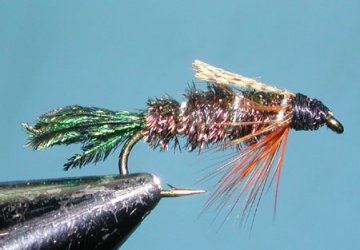
On The Fly
September 2011
"Fly tying is a school from which we never graduate"
TYING NEWS
The Southern Oregon Fly Tyers invite you to attend their meetings the second Tuesday of
each month. The next meeting is September 13, 2011. The meetings start at 6:00 PM, at the Madrone Hill
Mobile Home Park community building near Gold Hill. Bring a friend, come early so you don't miss
anything, and stay late. Tyers need not be experienced, and those with all levels of skill are
welcome. Each meeting a member is encouraged to demonstrate a new or different skill, from simple
to difficult. For more information, call Dan Kellogg at 773-4724.
DIRECTIONS: Take Gold Hill Exit #40, off of I-5 and go west, toward Jacksonville, 1.3 miles, until you
reach the brick entrance way to the Madrone Hill Mobile Home Park on the right. You’ll pass a golf course
parking lot on your left shortly after leaving the freeway. After you turn right into the
mobile home park, proceed to the community building which is located about 100 yards ahead on the left. The
address is 8401 Old Stage Rd. Please park your vehicle on the bare dirt in the parking lot to avoid the
wooden septic covers in the grass
 PATTERN OF THE MONTH -Zug-Bug
PATTERN OF THE MONTH -Zug-Bug
Hook: Daiichi 1710, 2X long nymph, size 6-16.
Thread: 6-0 or 8-0 black.
Weight: Optional lead wire
Tail: 3 Peacock sword fibers.
Rib: Fine oval silver tinsel or wire.
Body: Peacock herl, 5-7 strands.
Hackle/Beard: Brown soft hackle.
Wingcase: Lemon wood duck or turkey quill clipped short.
Tying Instructions:
Step 1 Mash the barb and mount the hook in the vise.
Step 2: Start the thread one eye width behind the eye and lay down an even thread base to a position just
above the hook barb.
Step 3: Select three Peacock sword fibers, measure at 3/4 body length and tie on right above the hook barb.
Arrange the fibers so each is pointed a different direction. Tie down the butts with open thread turns
toward the eye of the hook.<>br
Step 4: Cut a 4" piece of ribbing and tie it in behind the eye. With open thread wraps bind the ribbing
down to the top of the hook back to the base of the tail leaving the excess pointing towards the rear for
use after the next step.
Step 5: Select 5-7 Peacock herl strands and tie them on top of the shank, securing them with spiral thread
wraps the length of the body and back to the base of the tail. Grab the herl strands and make one wrap over
the shank and then counter clockwise around the tying thread. Grasp the herl and thread together and wind
the rope forward in touching turns covering 3/4 of the body length. Tie off the herl and trim the excess.
Step 6: Now take the ribbing and counter wrap it over the herl body in 5 evenly spaced turns. Tie off and
trim.
Step 7: Select a soft hackle feather with barbs as long as the body, pull off a bunch of fibers, place them
on the bottom of the shank just below the front of the body, and secure them with a couple firm wraps.
Spread the out slightly with your fingernail. Tie off and trim.
Step 8: Select a flank feather or a slip of turkey tail, secure it on top of the shank right above the
beard. Tie off and trim to length half way back on the body.
Step 9: Form a neat tapered head, whip finish, and cement.
Cliff Zug designed this fly in West Lawn, PA and it became a popular fly within the Catskills area. During the 1940's, it made it's way West to Yellowstone and beyond through the publications and articles of Arnold Gingrich. Today, like last month's pattern the Prince Nymph, this peacock-bodied nymph continues to be one of the top ten flies on many fly fishers lists. Although first intended to imitate cased caddis or free-living caddis larva, the fly suggests and is effective for many different insect species, mayflies, stoneflies, or even damsel and dragonfly nymphs. The Zug Bug takes full advantage of the attractive qualities of iridescent peacock feathers. It works well in a variety of situations where a dark general prospecting nymph pattern is called for. All types of fish find this fly appealing whether drifted or stripped in still waters.
TYING TIPS
Whether tying the Zug Bug weighted or not, it is important to form a cigar-shaped body. Utilize lead wire, dubbing, or thread buildup on the middle of the shank to promote the proper profile. The wingcase is a bit unique in that it is only tied down at the front and gives the fly a caddis-type wing appearance. The feathers from many different birds can be used to form the wingcase, but I prefer some kind of duck flank feather. I select one with barbs even at the tips, remove the fluff on both side of the stem, gather the barbs together, and tie it long on top of the shank with two wraps of thread. From there it's a simple matter to pull the stem butt forward until the wingcase is exactly the proper length and eliminates the need for cutting which makes for a more natural look. Try a bead head in larger sizes for Steelhead. This a simple tie using common material. Every nymph box should have some in different sizes.
So tie some up, give them a test flight, and let me know how you do.
Tie One On,
Dan Kellogg
(you can contact me at FLYGUY@EZNORTHWEST.COM)
www.tyerstoolshop.com